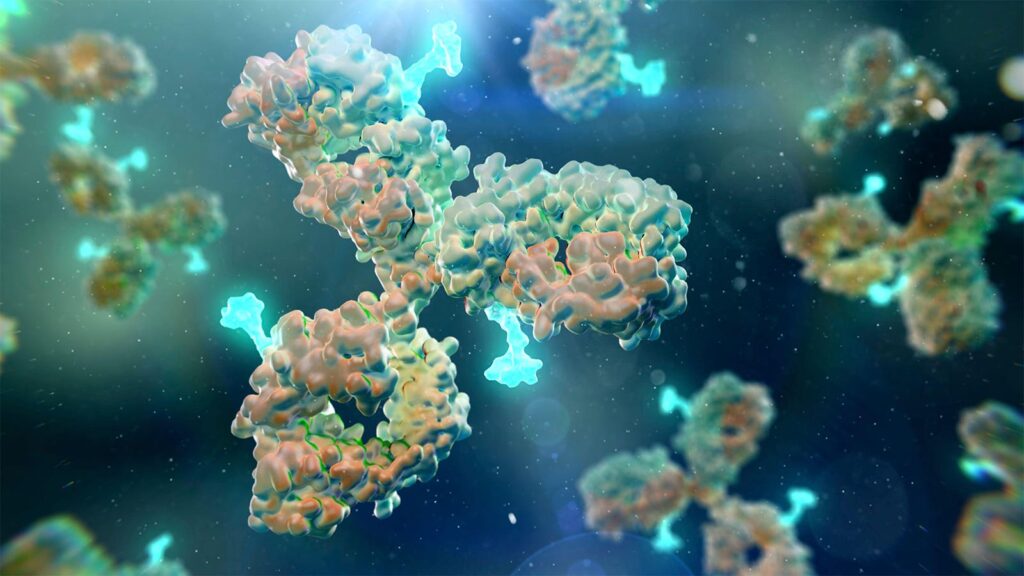- Investigational Lu AG09222 bested placebo in preventing migraine in a phase II trial.
- The treatment showed a 2-day difference in reducing monthly migraine days.
- Lu AG09222 targets PACAP, a vasodilating polypeptide.
A monoclonal antibody targeting a novel migraine prevention pathway showed success in the phase II HOPE trial.
A single 750 mg intravenous infusion of investigational Lu AG09222 bested placebo in reducing migraine frequency over the subsequent 4 weeks, reported Messoud Ashina, MD, of Copenhagen University Hospital–Rigshospitalet in Denmark, and co-authors.
At baseline, the mean number of monthly migraine days was 16.7. Through week 4, the Lu AG09222 group had 6.2 fewer monthly migraine days, while the placebo group had 4.2 fewer days (difference, -2.0 days, 95% CI -3.8 to -0.3, P=0.02).
Lu AG09222 targets pituitary adenylate cyclase-activating polypeptide (PACAP), a vasodilating polypeptide thought be involved in migraine pathophysiology.
“These findings affirm the proof of concept, showing that inhibition of PACAP signaling by Lu AG09222 represents a new and potentially effective mechanism for migraine prevention,” Ashina and colleagues wrote in the New England Journal of Medicine.
Early experiments reported that intravenous infusion of PACAP induced migraine attacks in migraine patients. A phase I study of healthy volunteers showed that Lu AG09222 inhibited PACAP-induced cranial artery dilation and reduced concomitant headache.
If Lu AG09222 ultimately is approved by the FDA, it will be the second class of monoclonal antibody treatments for migraine prevention — the first being antibodies to calcitonin gene-related peptide (CGRP) or its receptor, noted Elizabeth Loder, MD, MPH, of Brigham and Women’s Hospital in Boston, in an accompanying editorial.
“Although caution is advisable when results across trials are compared, the modest between-group difference of 2 migraine days per month observed in the current trial is similar to the results of trials of the CGRP monoclonal antibodies and lower than the difference observed with some established non-antibody preventive treatments for migraine, such as onabotulinum toxin A or topiramate,” Loder pointed out.
“Even if a new PACAP antibody is not more effective than existing treatments, its arrival is still valuable,” she added. “It is always good news when another potential target for migraine is identified and proves amenable to treatment.”
HOPE enrolled 237 patients with episodic or chronic migraine who had failed two to four previous preventive treatments. Participants were randomly assigned to receive a single-dose baseline infusion of 750 mg or 100 mg of LuAG09222 or placebo. Overall, 97 participants received 750 mg LuAG09222, 46 received 100 mg, and 94 received placebo.
Baseline characteristics were generally similar across the three trial groups. Mean age was 42.5 years, 100% of participants were white, and 88% were women.
The study included a 4-week treatment period and 8 weeks of follow-up. The primary end point was the mean change from baseline in the number of monthly migraine days during weeks 1 through 4 in the 750-mg group versus placebo. Participants completed a daily electronic diary to capture headache events, symptoms, and other data.
In the 4-week treatment period, the percentage of participants who had a reduction from baseline of at least 50% in the number of monthly migraine days was 32% in the 750-mg group and 27% in the placebo group.
Adverse events with a higher incidence in the treatment group versus the placebo group over 12 weeks included COVID-19 (7% vs 3%), nasopharyngitis (7% vs 4%), and fatigue (5% vs 1%).
There was one serious adverse event in the 750-mg group, identified as sympathetic posterior cervical syndrome, which was reported 1 month after the infusion. The participant had a history of vertebrogenic pain syndrome, and the event was deemed to be unrelated to Lu AG09222 treatment.
The study had several limitations, Ashina and co-authors acknowledged. “As a proof-of-concept trial, the sample size was small, the trial was short in duration and follow-up, and participants received only one dose of Lu AG09222,” they wrote. Migraine patients with clinically significant cardiovascular disease or other confounding health issues were excluded and findings may not be indicative of efficacy or safety in all migraine patients.
Because PACAP may play an important role in reducing neuroinflammation or ischemia, its safety when used in combination with other treatments will need scrutiny, along with better characterization of its effects in pregnancy, Loder noted. “The latter is particularly important because the majority of patients who receive treatment for migraine are women of childbearing age,” she wrote.
-
Judy George covers neurology and neuroscience news for MedPage Today, writing about brain aging, Alzheimer’s, dementia, MS, rare diseases, epilepsy, autism, headache, stroke, Parkinson’s, ALS, concussion, CTE, sleep, pain, and more. Follow
Disclosures
This study was funded by H. Lundbeck.
Ashina reported relationships with AbbVie, Amgen, AstraZeneca, Brain, Eli Lilly, GlaxoSmithKline, H. Lundbeck, Journal of Headache and Pain, Novartis, Novo Nordisk, Pfizer, and Teva. Co-authors were employees of Lundbeck.
Loder reported relationships with Brigham and Women’s Hospital, the British Medical Association, and the Headache Cooperative of the Northeast.
Primary Source
New England Journal of Medicine
Source Reference: Ashina M, et al “A monoclonal antibody to PACAP for migraine prevention” N Engl J Med 2024; DOI: 10.1056/NEJMoa2314577.
Secondary Source
New England Journal of Medicine
Source Reference: Loder E “A new antibody treatment for migraine” N Engl J Med 2024; DOI: 10.1056/NEJMe2406401.
Please enable JavaScript to view the

